Rachel Neumeier's Blog, page 211
December 17, 2018
Recent Reading: The Princess Seeks Her Fortune
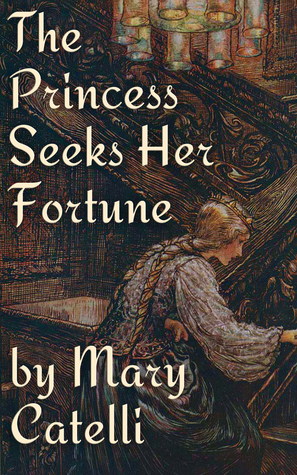
Okay, so, I didn’t count the number of fairy tales contained in this slim little story, but my rough estimate is: about 17,208.
Or if not, something close to that! If you’re interested, there’s an appendix so you could in theory go through and count the total references, but I didn’t, so I don’t know. All through the frame story, characters frequently recount fairy tales in a paragraph or two, mostly as family history because this is that kind of world. When it’s not family history, then it’s someone just passing through, wrapped up in their own fairy story.
What would it be like to live in a world chock full of fairy tales? And know it? A bit scary, for one thing; certainly it makes for ornate family histories. Fills the world up with potential, as anybody can set out to seek their fortune and wind up either cursed to ferry people across a river for hundreds of years or (of course) marrying a princess and inheriting half a kingdom.
So Allisandra, unappreciated by her family, sets out in just that way. She’s already carrying an obvious fairy tale blessing, having been polite when it counted; and a much less obvious blessing as well, having been selfless when it counted; and she surely has every reason to want to head out and leave her rather awful family behind. Let me see, I think she gets involved in five or six more fairy tales before the end.
Nice twist on the 12 Dancing Princesses: in this version, Allisandra rescues one dancing prince. Matteo was actually my favorite character: grim backstory, resourceful when it counts, and a sharp sense of justice.
Clever writing, ornate world, not a lot of character development but more than we see in actual fairy tales. Fairy godmothers, indifferent parents, selfish sisters, good friends, any number of enchantments — it all makes for a delightful story. About the only complaint I have is that I’d like it to have been twice as long so Matteo could’ve had equal time with Allisandra.
If you’re into fairy tales at all, especially if you’d like to try your hand at catching a million references to obscure fairy tales, definitely check this one out.
Please Feel Free to Share:









December 14, 2018
Making up languages
Words and the Lonely Writer, part 5 – Made Up Languages.
So, just like the occasional foreign phrase or foreign construction in English to give your book foreign flavor, save your made up language for occasional sentences, or constructions that follow the structure of that language. Remember that unless the meaning of the made up language is completely explained in the following or preceding text, people will stop and be annoyed.
Oh, and use it for naming conventions, if your world is that kind. That always goes over well, as people catch on to the pattern. Other than the use of apostrophes — they make the Baby Jesus cry — Anne McCaffrey did that wonderfully in the dragon world.
Mostly I just invent names! But I absolutely played around with inventing languages when I was a kid. (Doesn’t everybody?) And I absolutely did play around with apostrophes in exactly the most cliched manner possible, probably.
Now, of course, I kind of play around with accent marks because you can do that with Word, especially if you teach yourself to just use keyboard shortcuts to put an umlaut over a u or a downstroke over an i or whatever. After Winter of Ice and Iron, I can type with accent marks almost as fast as I can type without, though it’s a little harder to type certain accent marks now that I don’t use my left ring finger for typing. (You may not have heard about this because I don’t think I considered it important enough to mention here, but I made a real good try at snipping the tip of that finger off with gardening shears a few months ago. I will say that having stitches removed from the tip of your finger is dramatically more ouchy than I expected, but teaching myself not to type with that finger was really very easy; it literally took just minutes to teach myself to hit the s, w, and z with the middle finger of that hand.)
Anyway, moving on!
I have, as you know, two WIP that are essentially finished. They’re in completely, totally different worlds and they have quite different naming systems. I’ll call them OWIP (Obsessive WIP) and OWIP (Original WIP — oh, wait. Okay, how about FWIP (First WIP).
No, that looks stupid, because of course it does, because names are important and words are important. I’ll actually give you the completely pointless working titles:
Tuyo is the working title of the obsessive WIP because it’s an important word in the first chapter. Lahn is the working title of the first WIP because it’s the name of one of the two protagonists, though at this point not the opening protagonist because I gave this book a different opening chapter featuring the other protagonist during the course of revisions.
I have actually met writers who insist that they are unable to work on a project until they have a real title for it. Plainly that is not me. I have also met writers who can fill in character names with xxx or Bob or something until eventually, at the end, they actually name the characters. That’s not me either. I find both of those phenomena indescribably weird.
Names in Tuyo: most, maybe all of the names of the one language, taksu, end in -o or -a, but some feminine names end in -g. They’re mostly two or three syllables long, with a very simple consonant-vowel-consonent-vowel pattern. The names from the other language, darau, end in -n or -a or -au or -s; feminine names often end in -i. The words are often slightly more complicated and have more diphthongs.
And why? Because of the first names I gave characters in this book. The pov protagonist is Ryo and his people are called the Ugaro. The other protagonist is Aras and his people are called the Lau. All I was trying to do was think of names I haven’t used before, that don’t sound too much like the names of characters in other books, and those names happened to come into my head. Thus we see that the first names that occur to you may set up important rules for their whole languages, because something has to and you’ve got these first names to set the pattern.
Names in Lahn: Here the pattern was set in a completely different way: I simply based the sounds of the names on Vietnamese. Lots of -nh and -hn endings. Lots of vowels and double vowels. Not so many -ng endings because those can sound odd to the American ear, but lots of accent marks because those just look neat. The other main character is Vích, which I got from the Vietnamese name Bích, because obviously the latter is impossible for American readers unless the character is actually Vietnamese, but a “V” works fine. Oh, t says that for a girl named Bích, “life seems to be a long, peaceful river, and she emanates calm and gentleness.” Wow, that is absolutely not at all the case for my character Vích, so good thing I changed the letter. Lots of place names that are two words, like Duon Vu.
Other things a writer has to work out in order to deal with language in a secondary world: titles. You all helped a good deal with titles in Tuyo by talking to me about military titles (remember this post?) This was an issue here: made-up words vs normal American military titles vs some other option. I actually wound up going with Ellen’s suggestion, which involved familiar words implying function. Thanks, Ellen! I am happier with the titles now than I was with a mix of made-up words and American titles, so, though I’m not completely sure I won’t change some titles again, I greatly appreciate your suggestion.
I started reading Lahn from the top this morning to get back into that one, by the way. I got through nine chapters and found myself liking the story quite a bit, always a good sign. This part is all pretty well finished, or should be; I know I need to remind myself of various story elements I was putting in as I revised, because pretty soon I will get to the part where I’m still doing serious revision. Don’t want to let any important balls drop. For example, when I was writing the first draft, I didn’t know who the real antagonist was; I figured that out very close to the end. Now that I know who the antagonist is, I’m inserting hints about that person much earlier in the story and setting up the fundamental problem. It’ll all look smooth and effortless by the time you all see it, I trust, but I wrote this one in out-of-order chunks over a pretty long period, so it naturally has more ragged edges than Tuyo, which was written in one rapid whooosh.
In case you’re interested, my agent refers to Tuyo as “intense” and Lahn as “elegant.” I’m willing to take both of those as one-word descriptors!
Please Feel Free to Share:









December 13, 2018
I’m as prone to say KIDS THESE DAYS as the next person, but still —
Skim reading is the new normal. The effect on society is profound
I’m not sure I’m convinced. I’m not saying I couldn’t find this hypothesis plausible-ish:
We know from research that the reading circuit is not given to human beings through a genetic blueprint like vision or language; it needs an environment to develop. Further, it will adapt to that environment’s requirements – from different writing systems to the characteristics of whatever medium is used. If the dominant medium advantages processes that are fast, multi-task oriented and well-suited for large volumes of information, like the current digital medium, so will the reading circuit. As UCLA psychologist Patricia Greenfield writes, the result is that less attention and time will be allocated to slower, time-demanding deep reading processes, like inference, critical analysis and empathy, all of which are indispensable to learning at any age. [Bold is mine]
But I’m not sure I think that this article makes a totally persuasive case. For example, in the next paragraph, we have this:
Increasing reports from educators and from researchers in psychology and the humanities bear this out. English literature scholar and teacher Mark Edmundson describes how many college students actively avoid the classic literature of the 19 th and 20 th centuries because they no longer have the patience to read longer, denser, more difficult texts. We should be less concerned with students’ “cognitive impatience,” however, than by what may underlie it: the potential inability of large numbers of students to read with a level of critical analysis sufficient to comprehend the complexity of thought and argument found in more demanding texts…
And the reason I’m not keen on this paragraph is: Sure, absolutely, I totally agree that large numbers of the students I see are totally unable to read (or write) with anything resembling critical analysis. But I’m not remotely persuaded that reading on screens rather than from the printed page has anything to do with it. If we tried to list out the top 20 ways in which education in this country has changed for the worse in the past 50 years, do you think “on screen vs print” would make the list? I don’t. I can think of any number of other factors that look much more important to me.
This tidbit is interesting:
Mangen’s group asked subjects questions about a short story whose plot had universal student appeal (a lust-filled, love story); half of the students read Jenny, Mon Amouron a Kindle, the other half in paperback. Results indicated that students who read on print were superior in their comprehension to screen-reading peers, particularly in their ability to sequence detail and reconstruct the plot in chronological order.
But, first, since I perceive no such effect, and since I know lots of people who read ebooks and report nothing of the kind, I would like to see Mangen’s group’s methodology and raw data. And second, did that sentence about “a story whose plot had universal student appeal” make anybody else pause? Because, you know, I am pretty sure a lust-filled love story absolutely does not begin to have universal student appeal. Which may not be relevant since student disinterest, not to mention active repulsion, may have been randomly distributed between the two treatments, but it makes me wonder what other assumptions the researchers might have made, and with what effects on the patterns they thought they saw.
And not to throw stones, but the replication crisis in all science but especially social sciences makes me even less inclined to take a somewhat unexpected result and go “Oh well, didn’t see that coming and it doesn’t accord with my own experience, but it must be true.” These days my first, not second, reaction to all kinds of “research shows” claims is to say, I want to see your methodology. When any article begins by saying, “We know from research …” I immediately think of quite a list of things we thought we knew from research that are clearly not true, or at best highly questionable.
The placebo effect may not exist, for example. And not only are very well-known things of that nature now being called into question, but also it’s becoming increasingly plain that Fad topics can generate a whoooole lot of research that is actually all based on magical thinking and misinterpretation of data.
If you read that last linked post, be sure to get down to the part where this question is posed: “How do you get so many highly-cited papers speaking so confidently about every little sub-sub-detail of a phenomenon, if the phenomenon never existed in the first place?”
And so on and so forth. That chronic fatigue study in the Lancet that turned out to be utter junk, that ridiculously awful meta-analysis of second-hand smoke the EPA is shamefully responsible for, heaven knows what else.
The article goes on.
Ziming Liu from San Jose State University has conducted a series of studies which indicate that the “new norm” in reading is skimming, with word-spotting and browsing through the text. Many readers now use an F or Z pattern when reading in which they sample the first line and then word-spot through the rest of the text.
And I immediately think, Wait, wait, is this a new norm? Or is it the old norm, with any reading that is assigned, uninteresting, repulsive, or otherwise being resisted by the reader?
I just don’t find this kind of report all that suggestive of a change in reading habits due to screens rather than print. It looks to me like a non-change in reading stuff you’re not interested in. I want to know whether readers still skim if they’re reading something in which they’re interested, and if you tell me they do, I want to see your methodology.
I admit I’m still raising my eyebrows over that “universal student appeal” line and this is probably making me feel grouchy and critical about the whole paper, but still . . . lay out your methodology and let’s see if we can replicate your result with students, or for that matter adults, who are all allowed to read whatever they are actually interested in.
This is the only bit that seems persuasive to me:
The importance of recurrence for both young and older readers involves the ability to go back, to check and evaluate one’s understanding of a text. The question, then, is what happens to comprehension when our youth skim on a screen whose lack of spatial thereness discourages “looking back.”
I agree that this is tougher with ereaders and that I do dislike this feature — in fact, it’s the only feature of ereaders I dislike. The “search” function is just not as useful as being able to flip back and forth.
Nevertheless, the general message of the article — that youth today is suffering an urgent crisis in critical thinking ability and empathy because of ereaders — is a mite farther than I’m willing to go. If there’s such a decline, then I have a whole lot of other candidates in line as plausible culprits before I worry about the unphysicality of ebooks.
Please Feel Free to Share:









December 12, 2018
All dragons all the time
From Book Riot, a post by Silvana Reyes Lopez: 15 OF THE BEST DRAGON BOOK SERIES
I will say first: Pern’s missing from this list.
I grew up with Pern, I am still quite fond of Pern, I never believed in the time travel aspects of the series, but whatever. Plus Michael Whelan’s wonderful covers!


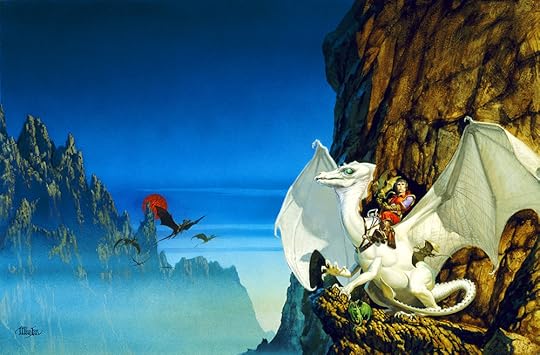
So, well, anyway, if you made a list of The Top 15 Dragon Series, not sure Pern would be on there, but if you made a list of The Top 15 Dragon Series Covers, then certainly.
Later I liked the Harper Hall trilogy best, but moving on, what are some great series featuring dragons? Let’s see what’s on this list from Book Riot first:
Ah, here’s Temeraire. Good choice. For me the series went kinda like this:

But I’m pretty sure some of you all commented that the series improved again later? I never read the last two books, and I sort of think I remember people saying I really should. I didn’t much like the Australian book. Let’s spend the entire book traveling across Australia! And back! With no progress in the larger plot!
And the book after that, the South American one, was worse. I did not like it AT ALL and remember practically nothing about it other than the fact I didn’t like it and the vivid fact that I just loathed the female fire-breathing dragon, what’s her name? Selfish, stupid, short-sighted creature. Maybe she improved eventually. Or was killed. Or shuffled off to an unimportant subplot somewhere, whatever.
Fine, moving on, what’s another series on this list I’ve read at least part of? Let me see …
Sorcerer and the Crown, Zen Cho,, I have the first one on my TBR pile. Dragons? I don’t remember anyone mentioning dragons. I read the first bit and it didn’t really grab me and I went on to something else, but I know lots of people loved this one so I should try it … someday …
Heartstone series, Elle Katherine White, I have the first one on my TBR pile. Pride and Prejudice, everyone says, with dragons. Not always wowed by things in the style of P&P because, really, it’s not that easy to compete with Jane Austen.
Invisible Library, Genevieve Cogman, I’ve heard a lot of thumbs-up reactions to that one.
Chronicles of Elantra, my my, there Michelle Saraga / West is again with her Elantra series. I vote for this being the most likely new-to-me series for me to actually try in 2019. Fourteen books out in this series, wow.
Various series I haven’t read, moving on …
Oh, here we go:
Lady Trent by of course Marie Brennan. I vote for this being the most likely series on this list for me to actually finish in 2019. I’ve got the more recent couple on the shelf downstairs but haven’t actually read them. I love the naturalist take on dragons that Brennan has going in this series and really, I am curious about how she wound up the series. No spoilers, please, but if you’ve read the whole thing, thumbs up or thumbs down on the resolution?
Then some more series I haven’t read . . . let me see, what besides Pern is missing? Well, how about these:
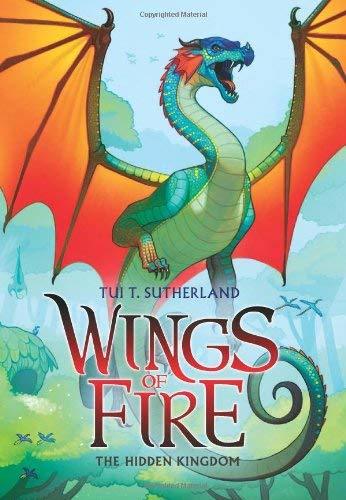
Granted, the Book Riot post didn’t include MG stories, but hey. I loved the original Dragonet Prophecy five-book series! Great MG series, one of my all-time favorites in the MG category. Looks like all five of the Jade Mountain quintilogy is out now, too. Well, this may be the most likely dragon series for me to go on with in 2019, bumping both the adult series down a notch.
Other dragon series … let me see, how about this one?
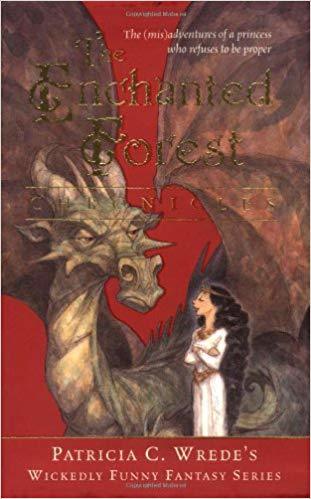
Patricia Wrede did some great work here. I do seem to be biasing my picks toward MG/YA, but still, Talking to Dragons surely belongs on any list of great-fantasy-series-with-dragons.
Oh, here’s an adult series I liked a lot:
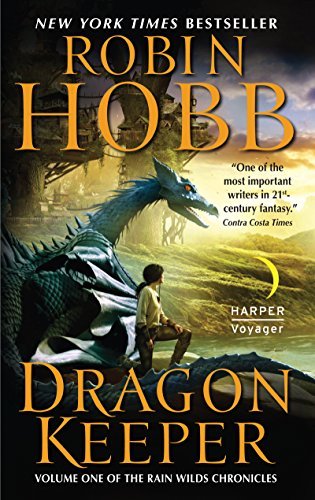
Robin Hobb is not my very favorite epic fantasy author, but I liked this series quite a bit. The dragons themselves were not that likable, which is one thing I kinda liked about them. Definitely not bred for docility, like some. Also just a lot of characters I liked and relatively few I disliked, not always the case for Hobb. Pacing: slow, but compared to the Assassin series, super super fast. Wow, was Fool’s Assassin slow. DNF for me, not because of the pacing. I had other issues with that series.
Anyway, I did like the Dragon series a mile better than anything else of hers I’ve read.
One more, not a series:
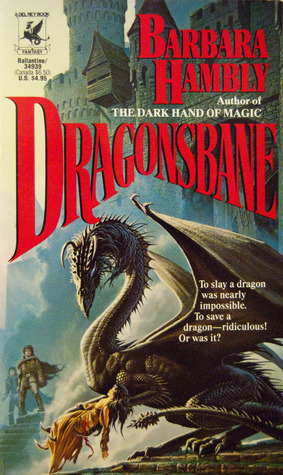
OKAY FINE so it technically is the first book of a series. I just sooooo do not recommend that anybody treat it that way. Dragonshadow, no. Knight of the Demon Queen, no no no. Dragonstar, sure, that one is finally not as grimly horrible, but it’s not worth it.
Dragonsbane yes. A wonderful dragon story. The rest of the series, no.
Okay! What have I missed? Throw a great dragon story, series or not, in the comments.
Please Feel Free to Share:









December 11, 2018
New Andrea K Host title —
Just saw this on Twitter, so if anyone else hadn’t realized:

Just came out a couple days ago.
Looking forward to it!
Please Feel Free to Share:









Liz Bourke wades into CJC’s Alliance/Union universe
Here at tor.com, this post: Jumping Into C.J. Cherryh’s Alliance-Union Books
Always pretty neat to watch someone discover a series you yourself discovered a zillion years ago, especially if you’re a fan. She’s picked one of my absolute favorite novels of Cherryh’s: Cuckoo’s Egg.
Let’s see what Liz Bourke has to say about this: … oh, never mind, she showed the cover of Cuckoo’s Egg, but has not apparently read the book. Plus she is discussing Alliance Rising, which is a CJC collaboration with Jane Francher. I’ve never read it and don’t know that I’m interested.
It looks like the two Bourke actually tried are Merchanter’s Luck and — ready? — 40,000 in Gehenna. Quick show of hands: who would suggest 40,000 in Gehenna as a good intro to Cherryh’s work?
Anybody?
Yeah, thought not.
Places to start with CJC, if she’d asked me:
Cuckoo’s Egg
Chanur series
Cyteen
Fortress in the Eye of Time
How about you? Where would you suggest readers start with CJC? Assume they tried Downbelow Station and bounced moderately hard, as I gather Liz Bourke may have done. I have a lot of sympathy with that: not one of my favorites and also imo not one of CJC’s most approachable books, either.
Please Feel Free to Share:









December 10, 2018
Finished! / Not Finished
The good part: I finished revising The Obsessive WIP last night, yay! For those of you who find this sort of thing interesting: I cut 170 pages from the original manuscript and added about 150 pages. It’s standing at 590 pages now, let me see, about 197,000 words. I could cut it more, but I have no major desire to delete anything at this point. We’ll see.
Do I like it better now? I don’t know, maybe, kind of? I like some things better, but I’m sorry to lose some of the scenes I cut, but those scenes did slow down the forward progress of the novel, so I don’t know. Some secondary characters are now a little more developed, which I like, and some stepped farther into the background or even vanished, which I guess is okay.
Agent’s best advice: The protagonist needs to be more central to the action in the last climactic battle. That was true. Plus the essential thing to do was clear immediately, always helpful in revision. (Make the protagonist confront his worst fear.) I did that, and still managed to save a lot of the last climactic battle.
The next thing is . . . my agent also suggested making the secondary protagonist a woman. I will try that and see how it works, because phrases like “more commercial” are persuasive even though I’m not super keen on the switch. As a man, this character is complicated and, it turns out, surprisingly feminine. That femininity immediately becomes both obvious and stereotypical if I change him into a woman. That, I don’t like at all, especially because it makes the male protagonist instantly look more stereotypically male as well. I’m considering ways to prevent this. One method has occurred to me, but I don’t necessarily like it and I’m not sure it would work anyway. I may try a couple of different things.
The less-good part: Not a disaster, but I definitely won’t be bringing Door Into Light out this year. It’s too late to do it before Christmas, and immediately after Christmas strikes me as a terrible time to bring out anything. The cover artist is behind due to, I believe, circumstances beyond her control, and I am taking this as a sign that I have plenty of time for one more round of copy edits. Did you know how easy it is to spell “soldier” as “solider”? And of course spell check won’t catch that. Going over it again won’t hurt, and anyway —
Just a note, but KDP is possibly having issues with printing paperbacks. The file I loaded is fine, but the proof copy they sent me this time has repeated chapter 17. I need to make sure KDP is printing accurate copies before hitting the go button and I don’t have time to deal with that right now, so —
The bottom line is, I’m looking at next year for Door Into Light. But earlyish next year! I will let you all know how that progresses.
Meanwhile: I have the last part of the revision to do for my Other WIP. If I can ONLY get ALL revisions finished BEFORE Christmas Break, I can take a stab at writing the 4th Black Dog novel, Copper Mountain, over Christmas Break.
Realistically, that won’t happen. Christmas Break starts on the 15th, or on the 14th if I happen to decide to take off Friday, and so there’s just no possible way. But I have every hope I can get all revisions finished before January 1, which would give me two weeks of the break left to take a stab at getting Copper Mountain at least moving….
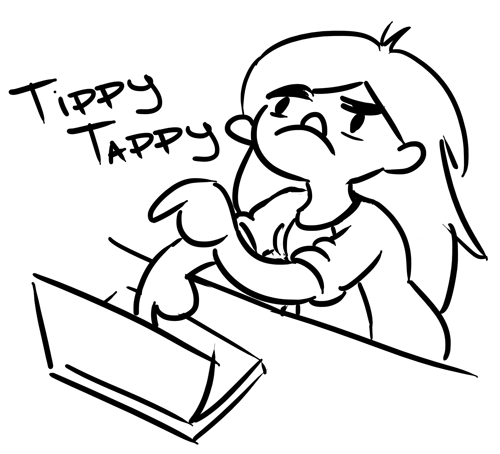
Please Feel Free to Share:









December 6, 2018
Top 10 wonderful authors I have only read one book by and this is terrible
You know what I think every time I think of Sarah Rees Brennan? (Which, I grant you, is not every day, but still.)
I think, “I loved the Demon’s Lexicon series so much (even if minor character xxxxx died, which I hated) — no, really, I loved this series so much, and she has all these other books out, and I would probably love them, and I might have some on my TBR pile at this very minute, and WHY have I not made time for more of her books?”
This year the answer is, “Because I have been obsessively working on my own books,” so the amount of guilt is trivial compared to this same thought in previous years, but I am still sad.
Something interesting is going on besides the standard So Many Books So Little Time phenomenon: I’m a little put off because I worry that I wouldn’t love another book of hers as much as I loved the trilogy I read first. This doesn’t happen all the time, but more often than not, if I just loved the first story I read, I may feel this kind of hesitation about going on to another, unconnected book by the same author.
This difference is exacerbated by feeling like I need to be able to give a book my undivided attention. In contrast, if I liked-but-didn’t-love a book, I will just go on to the next book by that author whenever I happen to have time to spare, even if I can’t offer it unadulterated attention.
This pause between falling in love with the first book of a new-to-me author and the second book from that author doesn’t happen every time, by any means, but for me it’s not uncommon. Does anybody else feel this way?
Anyway: Here is a Top Ten List of authors where my first feeling whenever I think of them is I really should go on with their backlist, damn it, and quit hesitating. For some, I have in fact read more than one story, but the backlist is extensive and I’ve wanted to dip further into it for a long time, but haven’t.
These authors are not in any particular order, just the order in which I happened to think of them:
Sarah Rees BrennanLaura Ruby. I’ve read only Bone Gap so far. James Hetley / James A Burton. I read Powers and Dominions and this is an excellent duology, but I’ve never tried any others of his, even though I have four or five on my Kindle at this moment.RJ Anderson. I’ve only read Knife. I really want to go on with more books by this author.Naomi Kritzer. I loved the Freedom’s Gate series, which was absolutely my favorite read of the year a couple years ago. She has another series out, and have I tried it? No. Joan Aikin. When I found out that Wolves of Willoughby Chase was the first book of a series, I was delighted. I read the second book, liked it very much, got the next book, and stalled out.Michelle Sagara / West. Kind of not right for this list because I have read two series by Sagara/West. One I didn’t like all that well, one I loved, there are so many more books in her backlist, I really want to try another series. Francis Hardinge. I’ve read two of her books, liked one a lot and loved the other, picked up two or three more of her books, and have never even opened them.Laini Taylor. I (mostly) loved the Daughter of Smoke and Bone trilogy, but have not been able to bring myself to read more than the opening paragraphs of Strange the Dreamer. This is one where I feel I need to give the book my undivided attention, and I don’t have undivided attention very often, so … China Mieville. I’ve read four of his, plus one DNF (Un Lun Dun), but it’s hard to think of another author where the hesitation to try another is stronger. I have at least two or three of his on my physical TBR shelves, but heaven knows when I’ll actually read any of them.
Please Feel Free to Share:









December 5, 2018
I think your definition needs work…
So, at Book Riot, this post — don’t click through yet —
Your Urban Fantasy Primer: Classics and New Releases.
Okay, I said, let’s see if we agree about at least the classics, though I’m sure I’m massively behind the new releases.
Now, tell me — don’t click through yet — what are some titles or some authors would you expect to see in a list of “classic urban fantasy?”
I would expect: Patricia Briggs, Ilona Andrews, Jim Butcher, Ben Aaronovich. I know that for me the first two intergrade with Paranormal, but they also spring to mind when thinking about UF; at least to my mind. The romance became more important to each series as the series progressed, but it wasn’t central at first.
Here are some others: the Inspector Chen series by Liz Williams, City of Bones by Martha Wells, Neverwhere by Gaiman, War for the Oaks by Emma Bull, no doubt plenty of others, these are some that spring to mind where the city itself is very important.
Some of the Vlad Taltos books, but not necessarily others, so I’m not sure about calling the series as a whole UF. How about that, if the urban setting is sometimes important but sometimes not at all important, is the series possibly UF or partly UF or not UF?
In general terms, what should qualify a book as Urban Fantasy? Here’s a nice graphic I found here:

Blow the page up with Control + to see this better, but basically the setting should be urban, fantasy elements should be present, romance should not be the core of the plot, and it can’t be secondary world fantasy. Except City of Bones is secondary world and actually I think that doesn’t exclude it, but your mileage may vary and at a later time I might agree that the setting must at least echo a contemporary setting.
Anyway. Urban fantasy, we know it when we see it, with quibbles around the edges.
All right, now. Classic Urban Fantasy according to this Book Riot post:
Neverwhere. Okay, so far so good. Watership Down. … … … not a hallucination. Watership Down.Mary Poppins. … … … seriously.Fledgling, by Octavia Butler.
I was out of … … … reactions by the time I got to Fledgling, which also I only ever read one time because it seemed to me like the first book of a series and I was sad there would never be a second book. I don’t remember it that well, or really at all, so I don’t know, maybe the setting was mainly urban. Could have been. Main character was a vampire, that’s all I remember.
I’m not bothered by whether Fledgling is a good choice or not because I’m so distracted by being very, very flummoxed over Watership Down. It’s “a powerful allegory of human society, group mentality, and humanity as a whole,” says Book Riot.
… … …
An allegory. Well, some of us read it as a story that has characters the human reader can identify with, but that does not, possibly, make it as allegorical as, I don’t know, Animal Farm. Are we going to declare that any book with animal characters is an allegory and that every allegory is really UF no matter how absolutely, completely, totally unlike Urban Fantasy it is in every possible way?
What else is really Urban Fantasy? The Last Unicorn? Uprooted? Is there ANYTHING that is out of bounds, if Watership Down is one of FOUR classic Urban Fantasies pointed out for special attention in this genre?
Okay, you can click through now. I have no idea what else is on this list because I was too amazed by the so-called classic UF selections to care.
Please Feel Free to Share:









December 4, 2018
Gingerbread Whoopie Pies
This is a great new recipe I tried this year and will be adding to the list of Christmas cookies from now on. I think I got it off the internet a few years ago, but who knows? Like all Whoopie Pie cookies, the cookie itself is quite soft and cakelike. The cream cheese filling is wonderful; I used the last bit of that as frosting for a cake I made for my mother’s birthday this morning.
Gingerbread Whoopie Pies
10 oz flour (2 C + 2 Tbsp)1/2 C sugar2 1/2 tsp ground ginger1 tsp cinnamon1 1/4 tsp baking soda3/4 tsp salt1/2 C molasses1/3 C vegetable oil1 egg1/3 C boiling water
Filling
2 1/2 C powdered sugar8 oz cream cheese1/2 stick of butter, softened2 tsp heavy cream, if necessary, to lighten the filling1 tsp vanilla
Combine the dry ingredients. Stir in oil, molasses, and egg. Add the boiling water and whisk until smooth.
Pipe or spoon by round spoonfuls onto parchment-lined baking sheets. Without going into details, I suggest piping the cookie dough, but whatever works for you. Bake at 350 degrees until puffed and just firm to the touch, about 12 minutes. Cool on the sheets 5 minutes. Remove to racks to cool completely.
Beat together filling ingredients. Sort out the cookies by size so you can make the nicest-looking cookies. I know that is a pain, but go ahead and do it. Pipe or spread filling onto bottom cookie of each pair and top with top cookie. Chill in single layer to firm up filling, after which you should be able to pile them onto a plate or into a tin.
I expect they freeze well. If they don’t, I’ll add a note to that effect when I discover it, but really, almost all cookies, even filled ones like this, do freeze perfectly. Soft cake-like cookies should be layered with waxed paper between the layers to help the cookies not stick together.
If you like gingerbread, you must try these. Mmmm.
Please Feel Free to Share:












